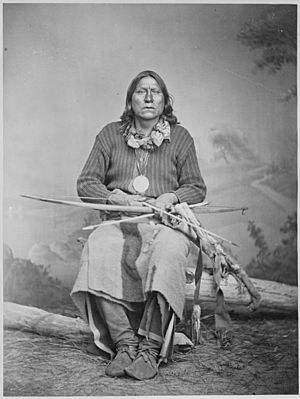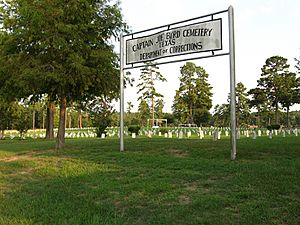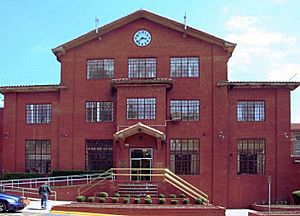Satanta (Kiowa leader) facts for kids
Quick facts for kids
Satanta
|
|
|---|---|
| Set'tainte (White Bear) | |

Satanta (White Bear), Kiowa chief, full-length, seated, holding bow and arrows and showing his presidential medal but not wearing his famous military jacket
|
|
| Born | ca 1820 |
| Died | October 11, 1878 (aged 57–58) Huntsville Unit in Huntsville, Texas
|
| Resting place | Fort Sill, Oklahoma |
| Nationality | Kiowa |
| Known for | A chief of the Kiowa Nation, warrior, orator |
| Parent(s) | Chief Red Tipi (Father) |
Satanta (also known as Set'tainte or White Bear) was an important Kiowa leader and warrior. He was born around 1820, when the Plains Tribes were very powerful. He likely grew up near the Canadian River, where his people often camped in winter.
Satanta became one of the most famous Kiowa war chiefs. He was known for being a brave warrior. When he was in his twenties, he became a sub-chief, or important leader, under Chief Dohäsan. Satanta fought alongside Dohäsan at the First Battle of Adobe Walls. He became well-known for using an army bugle to confuse enemy soldiers during the battle.
Satanta was the son of Chief Red Tipi and a Spanish captive. He spent his younger years south of the Arkansas River. During this time, the Kiowa and Comanche tribes were peaceful allies.
Contents
A Great Speaker and Warrior
Satanta was one of the most important leaders of his tribe in the 1860s and 1870s. He was respected for his skills as a warrior and his powerful speeches. Chief Dohäsan was the main chief until he passed away.
Satanta was one of the chiefs who talked with the American government about several agreements, called treaties, in the 1860s. These included the Little Arkansas Treaty (1865) and the Medicine Lodge Treaty (1867). In the Medicine Lodge Treaty, Satanta agreed that the Kiowa people would live on a special area of land called a reservation. When the tribe did not move to the reservation, General George Custer took Satanta. He was held until the Kiowa people were moved to the reservation.
The First Battle of Adobe Walls
Satanta is especially remembered for his role as a sub-chief at the First Battle of Adobe Walls. This battle happened in November 1864. Chief Dohäsan, along with Satank and Guipago, led the combined forces of the Kiowa, Kiowa-Apache, and Comanche tribes. They fought against Kit Carson and his New Mexico soldiers.
Satanta helped Dohäsan by leading many charges against the soldiers. He also famously blew an army bugle. This confused Carson's troops, as Satanta would play his own commands to counter the army's bugler. The Native American forces were much larger than the army group. They successfully pushed the US Army soldiers away from the battle area.
The Medicine Lodge Treaty
At the Medicine Lodge meeting, Satanta, a tall and strong man, became known as the "Orator of the Plains." This name came from his long and powerful speeches.
Like many agreements of that time, these treaties did not bring lasting peace. The Kiowa and Comanche tribes accepted the treaty offers. They promised to stop attacking settlers outside their reservation lands. However, soon after signing, the chiefs led their young men on raiding trips into northern Texas. This went against the treaty.
The Kiowa leaders were not happy that the reservation made their lands much smaller. So, they continued to lead their young men on raiding parties off the reservations. Many conflicts and attacks happened during the 1860s and 1870s.
The situation became even more difficult after Chief Dohäsan passed away in 1866. He was the last chief who led all of the Kiowa people. Without his strong leadership, the Kiowa people became less united. Several sub-chiefs, like Tene-angopte, Satanta, and Guipago (Lone Wolf), competed for power. This competition led to many raids across the southern plains in 1866 and 1867.
In one event, Satanta and a group of Kiowa and Comanche warriors raided into the Texas panhandle. They captured a woman and her four children, who were later released to the army.
Fort Zarah Incident
Satanta's fame grew after an event near Fort Zarah, Kansas, in 1867. A young Kiowa warrior was killed near the army fort. The Kiowa people gathered to get revenge for his death.
The cavalry soldiers also gathered to protect the civilians. Satanta was able to calm the situation and prevent a larger fight. However, later that day, the cavalry attacked the Kiowa camp. Satanta then led the warriors in defending the camp while the women and children moved to safety.
Warren Wagon Train Raid
In 1871, Satanta led several attacks on wagon trains in Texas. His capture came after the Warren Wagon Train Raid on May 18, 1871. Before this attack, the Native Americans had allowed an army ambulance with a small guard to pass by safely. General William Tecumseh Sherman was in the ambulance. However, Maman-ti, a medicine man, had told the chiefs to wait for a richer target.
The wagon train tried to defend itself by forming a circle with their wagons and putting their mules in the center. Even so, the warriors took all the supplies from the train and several wagoneers were killed. Five men managed to escape. When Colonel Ranald S. Mackenzie learned of the attack, he told General Sherman. Sherman and Mackenzie then searched for the warriors responsible.
Satanta openly spoke about his, Satank (Sitting Bear), and Ado-ete (Big Tree)'s involvement in the raid. Even though Guipago tried to help his friend, Sherman personally arrested Satanta.
Trial of Satanta and Big Tree
General Sherman ordered that Satanta and Big Tree, along with Satank, be put on trial. This made them the first Native American leaders to be tried in a US court for raids. Sherman ordered the three Kiowa leaders to be taken to Jacksboro, Texas, to face charges.
Satank did not want to be humiliated by a trial in the white man's court. He told the Tonkawa scouts that his family would find his body along the trail. Satank refused to get into the wagon. After soldiers forced him in, he hid his head under his red blanket. The soldiers thought he was ashamed, but he was actually biting his wrists to break free from his chains. He began singing his death song. When his hands were free, he used a knife he had hidden and tried to take a soldier's rifle. Satank was shot and died before he could fire.
His body was left in the road. His people were afraid to claim it because of the army. Colonel Ranald S. Mackenzie told the family they could safely claim Satank's body, but they never did. He is now buried at Fort Sill.
At his trial, Satanta warned what might happen if he was put to death: "I am a great chief among my people. If you kill me, it will be like a spark on the prairie. It will make a big fire - a terrible fire!" Satanta was found guilty and sentenced to death. However, the judge also wrote to Texas Governor Edmund J. Davis, suggesting that the punishment be changed to life in prison.
Governor Davis was under a lot of pressure from supporters of the Quaker Peace Policy. He decided to change the court's decision, and Satanta's punishment became life imprisonment. Satanta was released after two years in the Huntsville State Penitentiary in Texas.
Release, Recapture, and Death
In 1872, after much discussion with U.S. government officials, Guipago was allowed to meet Satanta and the young war chief Ado-ete in St. Louis. Only after this meeting did Guipago agree to go to Washington with other chiefs to talk about peace with President Ulysses S. Grant. Satanta and Ado-ete were temporarily released. Guipago led the Kiowa group to Washington in September 1872 and received a promise from the Indian Commissioner to release the two captives. Satanta and his companion were finally released in September 1873.
Soon after their release, Satanta and Ado-ete, along with Guipago and Tsen-tainte (White Horse), were present at the raid on Adobe Walls. However, the Kiowa people say that Satanta was only present and not actively involved in the fighting. He gave up his war lance and other symbols of leadership to younger, more aggressive men.
But his presence at the battle went against his release agreement. The government called for his arrest. He surrendered in October 1874 and was sent back to the state prison at Huntsville, Texas. Guards said that Satanta, forced to work on the road, would stare for hours at the traditional hunting grounds of his people. He seemed to lose his spirit. In his book, The History of Texas, Clarance Wharton wrote about Satanta in prison:
After he was returned to the penitentiary in 1874, he saw no hope of escape. For a while he was worked on a chain gang which helped to build the M.K. & T. Railway. He became sullen and broken in spirit, and would be seen for hours gazing through his prison bars toward the north, the hunting grounds of his people.

Satanta passed away on October 11, 1878.
Satanta was first buried in the prison cemetery in Huntsville. In 1963, his grandson, an artist named James Auchiah, received permission to move Satanta's remains to Fort Sill, Oklahoma.
In October 2000, Satanta's shield, bow, bow case, arrows, and quiver were returned to Fort Sill. A special ceremony was held, including the Fort Sill commander and Kiowa armed services veterans.
The character of Blue Duck in Larry McMurtry's famous novel Lonesome Dove was partly based on Satanta's life and death.
The actor Rodolfo Acosta played Satanta in 1959 in an episode of the ABC western television series, The Rebel, starring Nick Adams.
|


